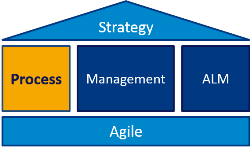
When you are ‘inside’ a process, managing or carrying-out its steps, the process tends to take all your attention, often obscuring its original purpose.
Agile Process Improvement
Our coaching method teaches you how to step-back and improve your own business processes. This process, which we call Agile Process Improvement, extends the purely software ambitions of the Agile Alliance. Its goal is to leverage the powerful and proven ‘pillars’ of Business Process Improvement (BPI) and Application Lifecycle Management (ALM) to achieve organisational goals.
Managers are the Keys to Success
Change initiatives that are driven purely from BPI or ALM are associated with enormous risks. With few exceptions, major changes implemented as ‘big bang’ or through ‘command and control’ approaches create a havoc that takes years to turn into advantage.
Research shows the commonest reasons for BPI failure are: management; communications; leadership; and major re-organisation. Paul Harmon, in Business Process Change, wrote:
… failure to manage processes effectively is the major cause of process problems
Little wonder then, that today’s middle managers have a real challenge: to make Agile work in a non-agile environment. Senior managers can’t advise how to do this as it has never been done before, and there simply are no ready-made answers, no templates to apply, no rules to follow.
Successful managers are leaders and communicators, determined to fix the specific business problems of their unique organisations.
What is Process Improvement?
Process improvement is the care and maintenance of business processes.
Everything we do at work is part of a process. Fixing bugs, adding features, joining planning meetings, even replying to customer emails, all are steps towards a bigger purpose. Some processes are more complex or structured than others, especially those where we engage with other stakeholders such as finance and compliance.
BPI, Lean, Total Quality Management, Kaizen and even flow-charting, all provide ways of improving processes. Automation is obviously the ideal, however it takes time and experience to specify the right model and there are costs associated with modeling and further costs of change.
Processes Need Continual Attention
Business process improvement should be an on-going activity. Processes are intended to serve the needs of the business but can easily become out of date and self-serving.
Business Analysis References
Modeling business processes and defining solutions is a business analysis activity according to The International Institute of Business Analysts (IIBA). Effective Business Analysts (BAs) work closely with senior stakeholders to help define the organisations goals and strategies.


